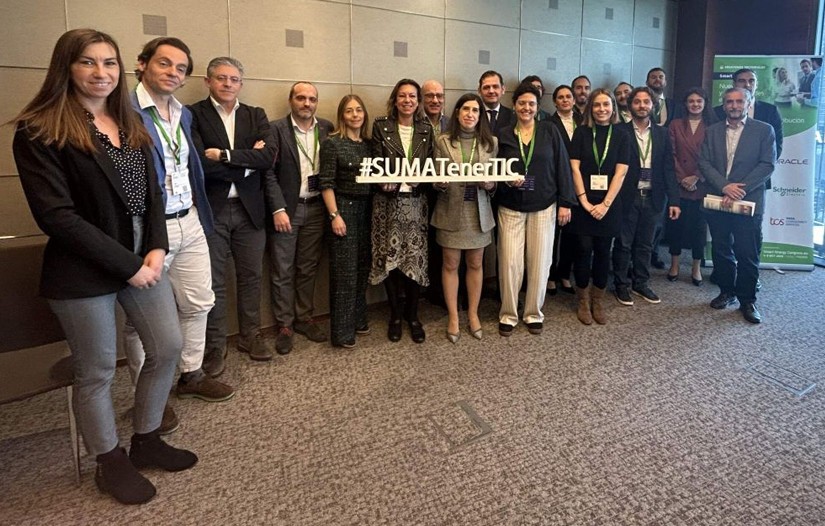Flexibility, cooperation, and technological innovation: this is what the energy distribution and retail sector needs to achieve its 2030 sustainability goals

The event brought together ASEME, Axpo, Cepsa, E-REDES, Enagas, Enel, Engie, Fortia, Visalia, I-DE (Iberdrola), Podo, Redexis, Soltec, UFD (Naturgy), and technology suppliers such as GMV.
The enerTIC platform recently held a new breakfast colloquium entitled: “New challenges and opportunities in energy sector transformation in the field of energy distribution and retail.” The event brought together the Spanish Association of Electricity Companies (ASEME), Axpo, Cepsa, E-REDES, Enagas, Enel, Engie, Fortia, Visalia, I-DE (Iberdrola), Podo, Redexis, Soltec, UFD (Naturgy), and technology suppliers such as GMV, to discuss the main challenges facing the sector in the coming years.
Increasing the presence of renewable energy
Last January, the European Commission (EC) endorsed Spain’s proposal to update its National Integrated Energy and Climate Plan (PNIEC) for the period 2023-2030, which the Spanish government had submitted to it the previous year. The proposal includes a number of updates to the measures set out in the 2020 plan. One of these is to increase the share of renewable energy in electricity generation from 74% to 81%, with greater prospects for installed capacity for all renewables.
Meeting this requirement is the main challenge facing energy distributors in Spain today, according to participants at the colloquium. The reality is that they will have to adapt their grids to accommodate these renewable energies. This means making their management systems more flexible, optimizing the energy they produce, increasing security, and minimizing losses, which can only be achieved by building new, more modern grids to replace the existing ones. According to participants at the event, 40% of Europe’s energy grid is more than 40 years old.
To meet this challenge, it is essential to move forward on the path of digital transformation and innovation. This involves automating the distribution network, especially at the low voltage level, which is closest to the end user. Participants also stressed the importance of implementing technological tools to integrate renewable energies into the system, in particular wind and photovoltaic energy, but also other alternatives such as hydrogen and biomethane, which require specific regulatory developments.
Regulation was another point raised during the colloquium, as its rigidity hinders the ability of the distribution sector to create and innovate. A stable regulatory framework should therefore be put in place to encourage long-term investment by simplifying authorization and licensing procedures and improving access to finance. In other words, regulators need to establish a clear roadmap that lays the foundations for the future of the energy sector.
The way forward for retailers
During the colloquium, energy retailers also outlined their key challenges, the first of which is to establish a framework for dialogue and cooperation with energy distributors in order to comply with regulations and meet the needs of end users.
However, the greatest challenge they face as companies is adapting to the rapid changes in society. Consumers are no longer passive and are now able to generate their own energy. In fact, of the 3% of energy that comes from self-consumption, 17% is domestic. The challenge for retailers is to manage this situation without complicating the lives of end users, and to adapt their infrastructure to this new reality.
Technology is an important ally for retailers on this journey. The implementation of smart meters and advanced demand management systems not only allows them to monitor energy consumption more accurately, but also to interact with consumers in a more dynamic and personalized way. These technologies enable dynamic pricing, which can incentivize efficient energy use and, in turn, optimize the power grid by reducing peak demand.
Meanwhile, digital tools and artificial intelligence play a crucial role in analyzing large amounts of data, enabling retailers to predict consumption patterns and tailor their energy supply more effectively. This predictive capability not only improves supply management, but also opens the door to new business models based on value-added services for consumers, such as predictive maintenance and personalized energy management.
At the same time, the integration of energy storage systems, both in the home and in the wider grid, is emerging as a fundamental solution for managing the integration of renewable energy sources. According to participants at the colloquium, the ability to store energy when production is high and demand is low, and then use it when consumption peaks, is key to maintaining grid stability and ensuring a constant supply to users. This, in turn, requires regulations that recognize and promote the role of energy storage, including incentives for its adoption by both businesses and consumers.
Finally, it is imperative that all stakeholders in the energy sector – governments, regulators, businesses, and consumers – work together to address the technical and regulatory challenges of this new energy era. Only through close cooperation and shared commitment will it be possible to build an energy system that is more resilient, sustainable, and suited to the needs of the sector in 2030.